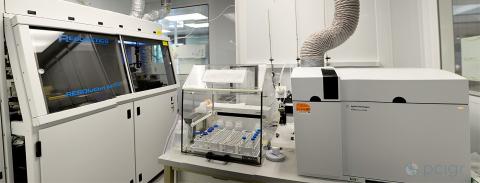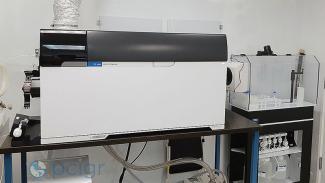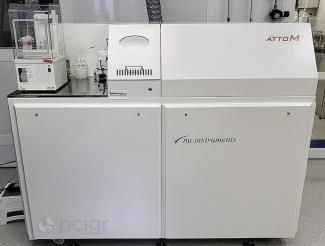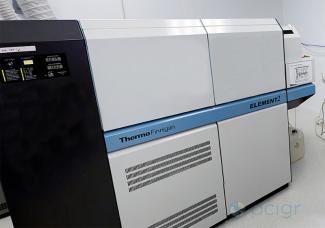PCIGR’s quadrupole and high-resolution ICP-MS instruments are configured to measure trace elements at ultra-low concentrations and/or lead (Pb) isotopic ratios at high-precision. We can provide analysis on a wide variety of sample media, from rocks and minerals to water and biological materials.
| Make/model | Configuration | Services |
| Agilent 7700x | Quadrupole | Trace element analyses |
| Agilent 8900 | Triple Quadrupole | Trace element analyses |
| Nu Instruments AttoM | High-resolution magnetic sector | Pb isotopic analyses |
| Thermo Scientific Element 2 | High-resolution sector field | Trace element analyses, Geochronology |
| Thermo Scientific Element XR | Extended range high-resolution | Trace element analyses, Geochronology |
* Each of our ICP-MS can be coupled to a split-stream laser ablation system
agilent7700xAgilent 7700x

Agilent 7700x quadrupole ICP-MS and RESOlution M-50-LR laser ablation system in the nUBC facility at PCIGR. Photo: D. Weis.
Installed at PCIGR in 2010, the Agilent 7700x is a single-quadrupole ICP-MS that is equipped with the following features:
- Cetac ASX-500 autosampler
- Frequency-matching RF generator
- Collision/reaction cell (He mode) for higher sensitivity, lower backgrounds, and effective removal of polyatomic interferences in complex sample matrices
The Agilent 7700x is used for analyzing trace elements (parts per million to billion range, ppm–ppb), in solution or in situ, in a variety of materials, including:
- Rocks
- Minerals
- Water
- Organic matter (e.g., honey, animal tissue)
- Culture media
For in-situ trace element analysis of solid samples, the Agilent 7700x is connected to an Resonetics RESOlution M-50-LR excimer laser ablation system.
For simultaneous measurement of trace element concentrations and isotope ratios on the same sample run, we use split-stream laser ablation ICP-MS. This technique connects both the Agilent 7700x and a Nu Instruments AttoM ICP-MS to the RESOlution laser ablation system.
Contact Vivian Lai for details on instrumentation and submitting samples.
Consult the Fees page for analytical costs.
agilent8900Agilent 8900

AGILENT 8900 TRIPLE QUADRUPOLE ICP-MS AND ESI PrepFast M5 LIQUID SAMPLE INTRODUCTION SYSTEM AT PCIGR. PHOTO: A. CHANG.
The Agilent 8900 triple quadrupole ICP-MS is a tandem mass spectrometer (ICP-MS/MS) that uses a collision/reaction cell with helium, hydrogen, oxygen or ammonia gas for reactions to remove polyatomic mass interferences and isobaric overlaps. This allows for high sensitivity and low backgrounds in ultratrace analyses.
Installed at PCIGR in 2023, the Agilent 8900 can be operated in solution mode with connection to an ESI PrepFast M5 sample introduction system (also installed in 2023), and in laser mode with our existing Elemental Science Lasers/New Wave Research NWR193UC laser ablation unit.
The Agilent 8900 is used for analyzing trace elements (parts per million to parts per billion range, ppm–ppb), in solution or in situ, in a variety of materials, including:
- Rocks
- Minerals (e.g., for critical minerals exploration)
- Waters
- Organic matter (e.g., honey, animal tissue)
Contact Vivian Lai and Dr. Marg Amini for details on instrumentation and submitting samples.
Consult the Fees page for analytical costs.
NuAttomNu Instruments AttoM

Nu Instruments AttoM high-resolution magnetic sector ICP-MS in the nUBC facility at PCIGR. Photo: V. Lai.
The AttoM is a double-focusing, high-resolution magnetic sector ICP-MS that is designed for precise and accurate isotope ratio analysis and elemental analysis of most elements down to sub-part-per-trillion (ppt) levels.
Installed at PCIGR in 2014, the AttoM is equipped with the following features:
- Cetac Aridus II or an ESI Apex desolvating nebulizer to increase signal sensitivity and reduce oxide and hydride interferences and matrix effects
- High signal sensitivity (e.g., only 0.2 ng of Pb needed in a single analysis)
- Electrostatic scanning capability, with the widest range in its class
- Two low-resolution deflector scan modes (peak jumping or peak scanning) up to 40% relative mass
- LinkScan mode (fast magnet scan combined with unique deflector optics) for time-resolved analyses, such as for laser ablation
- Detector system with a large dynamic range
The AttoM is used for analyzing trace elements and isotope ratios, in solution or in situ, in a variety of materials, including:
- Pb isotopes in seawater, ice, honey, fish
- Trace elements in rocks
For in-situ isotope ratio analysis of solid samples, the AttoM is connected to an Resonetics RESOlution M-50-LR excimer laser ablation system.
For simultaneous measurement of trace element concentrations and isotope ratios on the same sample run, we use split-stream laser ablation ICP-MS. This technique connects both the AttoM and an Agilent 7700x ICP-MS to the RESOlution laser ablation system.
Contact Vivian Lai for details on instrumentation and submitting samples.
Consult the Fees page for analytical costs.
tse2Thermo Scientific Element 2

Thermo Finnigan (Thermo Scientific) Element 2 high-resolution sector field ICP-MS at PCIGR. Photo: D. Weis.
The Element 2 is a double-focusing, high-resolution sector field ICP-MS that is capable of analyzing many elements in solution, at concentrations down to sub-part-per-billion (ppb) levels.
Installed at PCIGR in 2002, the Element 2 is equipped with the following features:
- Direct nebulization system (use of spray chamber)
- Dynamic range of over 9 orders of magnitude
Most interferences of elements caused by other elements in the sample matrix can be resolved by a careful selection of the resolution mode used, which minimizes the need for extensive chemical separation steps during sample preparation.
The Element 2 can analyze a wide suite of trace elements (including REEs, HFSEs, or both) in solution, in a variety of sample materials, including:
- Rocks, and standard reference materials in rock matrices
- Minerals
- Sediments
- Mine tailings
- Water
- Organic matter
- Pharmaceuticals
The Element 2 can also be connected to an Elemental Science Lasers/New Wave Research NWR193UC laser ablation system for the following in-situ analyses:
- U-Pb geochronology of zircon and monazite
- Trace elements in garnet
For simultaneous measurement of Hf isotope ratios and U-Pb geochronology on the same sample run, we use split-stream laser ablation ICP-MS. This technique connects both the Element 2 and a Nu Instruments Nu Plasma ICP-MS to the NWR193UC laser ablation system.
The Element 2 is also used extensively at PCIGR for QA/QC, as follows:
- Lab blanks
- Reagent blanks
- Column calibration
- Exact elemental contents of samples prior to analysis by multicollector ICP-MS
Contact Vivian Lai for details on instrumentation and submitting samples.
Consult the Fees page for analytical costs.
tsexrThermo Scientific Element XR

Thermo Scientific Element XR extended range high-resolution ICP-MS at PCIGR. Photo: A. Chang.
The Element XR is an extended dynamic range, high-resolution ICP-MS that is capable of analyzing many elements in solution, at concentrations down to sub-part-per-billion (ppb) levels.
The system was acquired from UBC-Okanagan and installed at PCIGR in 2024.
The Element XR is currently unavailable while we optimize the system. Please check back later. Thank you for your patience.